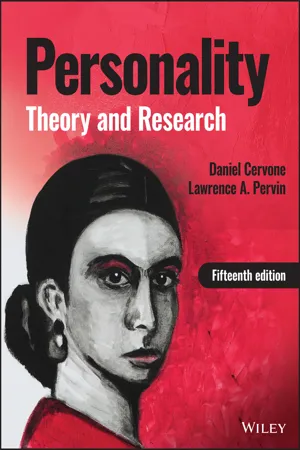Psychology
Genetic Basis of Behaviour
The genetic basis of behavior refers to the influence of an individual's genetic makeup on their behavioral traits and tendencies. It encompasses the study of how genes contribute to various aspects of behavior, such as personality, intelligence, and mental health disorders. Research in this area aims to understand the complex interplay between genetic factors and environmental influences in shaping human behavior.
Written by Perlego with AI-assistance
Related key terms
1 of 5
11 Key excerpts on "Genetic Basis of Behaviour"
- eBook - ePub
- Matt Jarvis(Author)
- 2005(Publication Date)
- Routledge(Publisher)
8 Biological psychology 1: genetic influences on behaviour
Key assumptions of the approach Behavioural genetics: the genetics of individual differences Evolutionary psychology: the genetics of human similarity Contemporary issue: does behavioural genetics pose a threat to other psychological approaches? Contributions and limitations of genetically based approaches SummaryKey assumptions of the approach
Have you ever wondered why a particular characteristic like high IQ or perhaps a bad temper seems to run in your family? Thinking about people more generally, have you ever considered why people prefer to go to the toilet alone, or why a young man going out with an older woman raises eyebrows whereas no one looks twice at an older man partnered with a young woman? Although there are many possible explanations for these patterns, there has recently been an upsurge of interest in biological explanations for these and many other psychological phenomena. Over the next two chapters we shall look at three major concepts from biology that have proved useful in explaining human psychology—genetics, evolution and neurophysiology.Genetics is the study of inheritance, and has been applied to psychology in looking at the extent to which psychological characteristics are affected by inheritance from parents. Evolution - eBook - ePub
- Nancy Fenton, Jessica Flitter, Jessica Flitter(Authors)
- 2015(Publication Date)
- Research & Education Association(Publisher)
Chapter 5 Biological Bases of BehaviorBiological psychology can be traced to the beginnings of psychology because it has its roots in physiology. The field of biological psychology , also called neuroscience , focuses on how genes, the nervous system, and the endocrine system influence behaviors and mental processes. Technological advances have allowed biological psychologists to provide a more complete understanding of what occurs on a physiological level during a psychological experience such as thinking or memory.Heredity, Environment, and EvolutionAn important aspect of the study of psychology is the interplay among genetic, environmental, and evolutionary influences. Complex human traits, such as intelligence, aggression, altruism, and personality, are influenced by all of these factors. For instance, psychologists attempt to determine how an individual’s level of aggression is impacted by inheritance and exposure to violence, as well as why aggressive tendencies were naturally selected.Biologists and psychologists are both interested in the various influences of nature and nurture on human traits. Biologists study physical traits, such as height and eye color, or susceptibility to diseases, such as cancer. In contrast, psychologists are interested in behavioral traits and psychological illnesses. Behavioral traits include aggression, intelligence, personality, etc.; psychological illnesses include anxiety, schizophrenia, depression, etc. The scientific discipline of behavioral genetics attempts to integrate the influences of heredity, environment, and evolution in terms of their effect on human behavior.HeredityBiological psychologists are interested in the study of heredity, or how the traits of parents are transmitted biologically to offspring. The nucleus of each human cell contains forty-six chromosomes , twenty-three donated by each parent. Chromosomes that determine gender are known as the X and Y chromosomes . One X chromosome is donated by the mother, and either an X or Y chromosome is donated by the father. An XX individual is female; an XY person is male. Each chromosome contains genes , which are made up of a chainlike molecule called deoxyribonucleic acid (DNA) . Each individual gene can be either dominant or recessive. A dominant gene takes precedence over a recessive gene for that particular trait. For the gene that determines eye color in humans, brown is the dominant gene and blue is the recessive gene. If either parent donates a dominant gene for eye color, the child will have brown eyes. If both parents donate recessive genes for eye color, the child will have blue eyes. A Punnett square can be used to predict the outcome of various traits. The genotype is the genetic makeup for a trait in an individual, which may or may not be expressed, while the observable characteristics of genes are referred to as the phenotype - eBook - ePub
Growing Points in Developmental Science
An Introduction
- Willard W. Hartup, Rainer K. Silbereisen(Authors)
- 2005(Publication Date)
- Psychology Press(Publisher)
3 Behavioural genetics in the 21st century
Robert Plomin
Institute of Psychiatry, London, UKThe controversy that swirled around behavioural genetics research during the 1970s has largely faded. During the 1980s and especially the 1990s, the behavioural sciences became much more accepting of genetic influence, as can be seen in the growing number of behavioural genetic articles in mainstream behavioural journals and in research grants. In my view, this is one of the most dramatic shifts in the modern history of the behavioural sciences. The purpose of this chapter is to consider new directions for research in the field of behavioural genetics.Behavioural genetics is the genetic study of behaviour, which includes quantitative genetics (twin and adoption studies) as well as molecular genetics (DNA studies) of human and animal behaviour broadly defined to include responses of the organism, from responses measured in the brain, such as functional neuroimaging, to self-report questionnaires. Although animal models permit more powerful methods of analysis because both the genome and the environment can be manipulated, the present chapter focuses on genetic research that can be conducted in the human species.No crystal ball is needed to predict that the momentum of recent developments will carry the field of behavioural genetics well into the new millennium. This momentum is propelled by new findings, methods, and projects in quantitative genetics and especially in molecular genetics. The momentum will grow stronger as genetics continues to flow into the mainstream of behavioural research. Instead of only a hundred or so behavioural geneticists working on personality and cognition (and again as many in psychopathology), more behavioural scientists will incorporate these techniques in their research. This “giving away” of behavioural genetics is already happening, with some well-known behavioural scientists leading the way (Plomin, 1993). This is an important trend because the best behavioural genetic research will be done by behavioural scientists who are not primarily geneticists and who use these methods to address theory-driven issues in their speciality fields. For this reason, a major motivation for writing this piece is to entice other behavioural scientists, and especially the next generation of behavioural scientists, to incorporate genetics in their research. - David Pilgrim, Anne Rogers, Bernice Pescosolido, David Pilgrim, Anne Rogers, Bernice Pescosolido(Authors)
- 2010(Publication Date)
- SAGE Publications Ltd(Publisher)
7 INTRODUCTION My starting assumption is that genes are ‘involved in’ behaviour; consequently, genetic variation contributes to variation in behaviour. To deny that would be not merely unreasonable but incoherent, although there is still some appetite for the old nature – nurture pseudo-controversy. The too-crude dismissal of the impor-tance of genetic factors can still appeal to those who enjoy attacking the straw-man genetic determinist, who is thought to argue for the ‘primacy’ of genetics over the environment (Sonuga-Barke, 2010). If there is any sense in talk of the ‘primacy of genetics’, it is that an individual’s set of genes is given and fixed from conception and is from then on available for interaction with the (changing) environment. What does not make sense is to think of either an individual’s genes or their environment as being the principal determinant of future behaviours in isolation from their environment or their genes (respectively). A full repertoire of genes is required for all behaviour (whether the latter is designated as normal or abnormal). All but a few of the smallest chromosomal deletions, that result in some genes being present in one copy per cell instead of the usual two, are associated with cognitive impairment and therefore with dif-ficulties for the individual in organizing their behaviour. Even chromosomal duplications – resulting in three copies of the relevant genes – usually affect cognition and behaviour as well as other aspects of growth and development. 1 The Limits to Psychiatric and Behavioural Genetics A n g u s C l a r k e THE SAGE HANDBOOK OF MENTAL HEALTH AND ILLNESS 8 Such chromosomal anomalies become interesting – and challenge our understanding – when we find that a particular deletion or duplication is associ-ated not merely with a diffuse cognitive impairment but with some more specific and unusual behaviours.- eBook - ePub
- J.N. Spuhler(Author)
- 2017(Publication Date)
- Routledge(Publisher)
Behavior Genetics as the Study of Mechanism-Specific Behavior Delbert D. Thiessen and David A. RodgersBEHAVIOR GENETICS is rapidly gaining acceptance as a substantive discipline within psychology. In the 1965 Annual Review of Psychology, Bell observed that “the burgeoning and productive field of behavior genetics in animals hardly seems in need of advocacy” (p. 3). In the 1966 Annual Review, McClearn and Meredith called the growth “explosive.” The direction of growth of this vigorous infant is already a matter of concern and controversy. For example, Caspari (1963) comments that the most direct approach to behavior by genetic means will “not turn out to be very promising.” He is referring to the establishment of differences in behavioral characteristics between strains or sublines and subsequent analysis of their genetic behavior in crosses, a common paradigm of behavior genetics studies.Commenting on the same trend, Ginsburg (1958) observed that such an approach “brings us to the threshold of a locked door.” Notwithstanding these misgivings, the main emphasis of the behavior genetics movement still seems to be, as Meissner has recently expressed, “on the determination of the genotypes corresponding to the psychological phenotypes. The overriding concern [is] to identify the genetic factors to which the observed variance in psychological abilities and performance could be ascribed” (1965). These goals may be partly a reaction against past tendencies toward overgeneralizations that are based on genetically heterogeneous colonies of laboratory rats and that assume biological differences of behaving organisms are of little consequence. Commenting on such overgeneralization, Bitterman (1965) wrote, “It is difficult for the nonspecialist to appreciate quite how restricted has been the range of animals studied in experiments on animal learning because the restriction is so marked.” - eBook - PDF
Personality
Theory and Research
- Daniel Cervone, Lawrence A. Pervin(Authors)
- 2022(Publication Date)
- Wiley(Publisher)
Genes may be thought of as sources of information, directing the synthesis of protein molecules along particular lines. Information in the genes, then, directs the biological development of the organism. In appreciating the relation of genes to behavior, it is important to understand that genes do not govern behavior directly. Thus, there is no “extraversion gene” or “neuroticism gene.” To the extent that genes influence the development of personality characteristics, they do so through the direction of the biological functioning of the body. In addition, a single gene does not determine a trait. Rather, a personality trait reflects the interaction of many genes with many environmental influences (Turkheimer, 2006) as well as the interaction of genes with one another (Keller et al., 2005). Behavioral Genetics Genetic contributions to personality styles and personal capabilities are studied in behavioral genetics. This field of study pursues a series of scientific goals. One is obvious: To determine whether genetic influences contribute to a given observed psychological quality. A second is somewhat less obvious: To determine whether environmental factors contribute to a psycho- logical quality; behavioral genetic research often provides strong evidence not only of genetic, Courtesy of Grazyna Kochanska The developmental psychologist Grazyna Kochanska has explored the origins of children’s capacity for self-control. Mother’s Assertion of Power Children’s Effortful Control Children’s Conscience – + FIGURE 14.2 Conceptual representation of relations among mother’s assertion of power, children’s effortful control, and the development of conscience among children, based on data from Kochanska and Knaack (2003). The minus and plus signs indicate that higher levels of power assertion among mothers predicted lower levels of effortful control in children, and higher levels of effortful control predicted higher levels of conscience. - Lorelle J. Burton, Drew Westen, Robin M. Kowalski(Authors)
- 2022(Publication Date)
- Wiley(Publisher)
Cognitive neuropsychology is a branch of cognitive psychology that aims to understand how the structure and function of the brain relates to specific psychological processes. 6.5 Describe the relative roles of genetics and environment in psychological functioning. • Environment and genes interact in staggeringly complex ways that psychologists are just beginning to understand. Psychologists interested in genetics study the influence of genetic blueprints (genotypes) on observable psychological attributes or qualities (phenotypes). Studies in behavioural genetics suggest that a sub- stantial portion of the variation among individuals on many Pdf_Folio:277 CHAPTER 6 Biological bases of mental life and behaviour 277 psychological attributes such as intelligence and personality is heritable. Heritability refers to the proportion of variability among individuals on an observed trait (phenotypic variance) that can be accounted for by variability in their genes (genotypic variance). KEY TERMS acetylcholine (ACh) A neurotransmitter involved in muscle contractions, learning and memory. action potential A temporary shift in the polarity of the cell membrane, which leads to the firing of a neuron. adrenal glands Endocrine glands located above the kidneys that secrete adrenaline and other hormones during emergency situations. adrenaline A hormone that triggers physiological arousal, particularly in potential danger situations. amygdala A brain structure associated with the expression of rage and fear and calculation of the emotional significance of a stimulus. association areas The areas of cortex involved in putting together perceptions, ideas and plans. autonomic nervous system The part of the peripheral nervous system that serves visceral or internal bodily structures connected with basic life processes, such as the beating of the heart and breathing. It consists of two parts: the sympathetic nervous system and the parasympathetic nervous system.- eBook - PDF
- Albert R. Gilgen(Author)
- 2013(Publication Date)
- Academic Press(Publisher)
Before such principles evolve, however, it is necessary to determine the extent of individual differences and place them in a more general context. I. THE EXTENT OF INDIVIDUAL DIFFERENCES Perhaps the widest theoretical cleavage between general psychologists and behavior geneticists has occurred over the view of fundamental biological processes underlying behavior. Psychologists, in the main, have held tena-ciously to the notion that all species and populations, especially mammalian, are put together in basically the same way, and that species and individual parts are interchangeable, at least conceptually. There is credibility in the notion that to some degree at least behavior is managed in the same way at all species and population levels. A neuron, regardless of species, conducts impulses on the background of membrane changes involving potassium and sodium; a reflex is a stimulus-response arc whose form is virtually invariant for all neurologically wired organisms; and an endocrine organ and its BEHAVIOR GENETICS! ITS RELATION TO BIOLOGY 73 chemical secretions are pretty much alike regardless of phylogenetic status. Variations often seem to be quantitative oscillations around the same theme, and, accordingly, add little to basic knowledge. Considerable data have now been amassed against this extreme premise in the form of individual and species variations on almost all conceivable behaviors and physiological processes. Behaviors and mechanisms simply are not always the same in different genetic forms. With the possible exception of monozygous twins, all individuals are genetically unique. One source of variation is alternative forms of the same gene (allele) which may appear at the same chromosome site (locus). If only one chromosome locus with two allelic alternatives is considered, say A and a, three genetic classes are possible: AA, Aa, and aa. - eBook - ePub
Biotechnology in Our Lives
What Modern Genetics Can Tell You about Assisted Reproduction, Human Behavior, and Personalized Medicine, and Much More
- Jeremy Gruber, Sheldon Krimsky(Authors)
- 2013(Publication Date)
- Skyhorse(Publisher)
4 Problems may occur when this faulty premise leads to the “informal application” of tentative behavior-genetic correlations, especially in the context of DNA databases. Individual rights and the rights of disadvantaged populations will be put at risk at early phases of criminal investigation, when such databases are used to select potential suspects in criminal cases.Behavior genetics: the new hype
Most practicing human behavior geneticists have abandoned former research designs based on twin studies and embrace newer methodologies based on direct correlations between DNA sequence variation and variation in performance on behavioral measurements. The first stage of such an investigation is to survey a very large number of known human genes that exhibit many variations to find statistical correlations between variant gene alleles and the incidence of some behavioral syndrome, such as schizophrenia or abnormal aggressiveness. Among the genes for which statistically significant correlations are found, those known to code for gene products that would reasonably seem to be related to the central nervous system are identified as “candidate genes” for further investigation. There are two serious problems with this approach.The first is a statistical fallacy. A correlation between two variables is considered “statistically significant” if a correlation as large or larger than the one observed would rarely occur by pure chance in a sample of observations, without any real causal connection. In conventional practice, “rarely” means 5 percent of the time or less. But if one surveys, say, 10,000 genetic polymorphisms for a correlation with a behavioral syndrome, then by chance up to 500 of those polymorphisms could turn out to be significantly correlated to the behavior at the 5 percent level of significance even if none of them has any real causal relation to the syndrome. How is one to decide which, if any, of these genetic variations is causal? One possibility is to run a second, independent, study on a new sample and see how many of the original 500 significant correlations will show up again. But by pure chance 25 (5 percent of 500) of the original correlations will appear in both samples. How many of these are real? And how many real connections have been missed because a relevant gene polymorphism only increases the probability of the behavior by a small amount too weak to be detected by the study design? - eBook - PDF
Genetics, Environment, and Behavior
Implications for Educational Policy
- Lee Ehrman, Gilbert S. Omenn, Ernst Caspari, Lee Ehrman, Gilbert S. Omenn, Ernst Caspari(Authors)
- 2013(Publication Date)
- Academic Press(Publisher)
Chapter 10 Human Behavioral Genetics N. E. MORTON University of Hawaii Honolulu, Hawaii The population geneticist tries to make mathematics serve biology. The behavioral geneticist tries to make biology serve psychology. My training and interests prevent me from exploring this possible conflict, and I shall re-strict my discussion to the use of mathematics to answer certain biological questions about human behavior. What Are the Effects of Single Genes on Behavior? The rationale for single-gene studies was given by Thiessen et al. (1970). The beauty of single gene analyses lies in the possibility of tracing the phys-iologic interactions from the initial gene alteration to the behavior in ques-tion. The alleles can be easily identified, manipulated as independent varia-bles, and, in several cases, related to known metabolic pathways. It is as if only one letter of a word is allowed to vary at a time in order to study its special influence. 247 248 N. E. MORTON As in the mouse and Drosophila, many neurological mutants are known in man with gross effects on behavior, and probably a large fraction of oth-er mutants modify behavior more discreetly. Considering that the academic interest of this material is reinforced by immediate prospects for better man-agement of disease, surprisingly little research has been directed toward characterizing these effects, especially the more subtle and specific carrier signs. Some mutants, like total albinism, are similar to (and may be homol-ogous with) genes in the mouse with known effects on behavior (including activity level and alcohol preference in the case of albinism). It is an inter-esting problem whether these effects are similar in mouse and man. - eBook - ePub
The Welfare Trait
How State Benefits Affect Personality
- Adam Perkins(Author)
- 2016(Publication Date)
- Palgrave Macmillan(Publisher)
6 Genetic Influences on PersonalityThis chapter summarises evidence for the genetic transmission of personality characteristics from parents to offspring. This topic might seem like a matter for debate or even controversy, but it isn’t: long before the advent of behaviour genetics as a scientific discipline, farmers used selective breeding to mould the psychological as well as anatomical characteristics of their livestock. For example, sheep are docile and passive farm animals yet the wild sheep from which they are descended are feisty creatures. This change in sheep personality is not the result of education, but instead has been achieved by centuries of selective breeding for docility.Charles Darwin’s rural background no doubt gave him a head start when it came to understanding the power of selective breeding to alter psychological characteristics. He was certainly aware of it, as demonstrated by this bold statement in the final chapter of the Origin of Species: ‘Psychology will be based on a new foundation, that of the necessary acquirement of each mental power and capacity by gradation’ (Darwin, 1859, p. 458). I say this was a bold statement because psychology barely existed as a scientific discipline at the time and, indeed, the first psychological laboratory was not set up until 20 years later (by Wilhelm Wundt at Leipzig University, in 1879).The theoretical framework for this chapter is therefore a well-known one, namely evolution by natural selection. It has been called ‘the single best idea anyone has ever had’ (Dennett, 1996, p. 21) and more words have probably been written about it than any other scientific theory. This might give the impression that it is difficult to understand. It isn’t. As I intimated above, natural selection is just like selective breeding for docility by farmers, except that instead of a farmer selecting which animals get to pass on their genes, it is the environment in the broadest sense of the word (such as climate, other organisms and geological factors).
Index pages curate the most relevant extracts from our library of academic textbooks. They’ve been created using an in-house natural language model (NLM), each adding context and meaning to key research topics.










